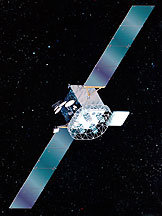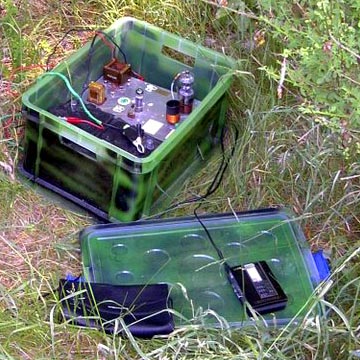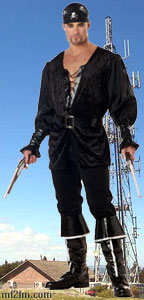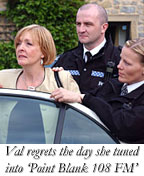Friday 31 August, 2007, 10:48 - Pirate/Clandestine
Posted by Administrator
Since the late 1990's rumours have abounded that it was possible to hack into American military satellites and use them for wide area communication. The satellites, originally the 'FleetSatCom' newtork (often abbreviated to FLTSATCOM) use basic FM modulation and have uplinks in the area of 300 MHz and downlinks in the area of 260 MHz. Stories went that tuning in to the downlinks it was possible to hear illegal pirates, from Brazil in particular, who were usurping these US military satellites to use for wide-area communications. It was also said that 'Smile 93.9 FM' (rumoured to be from Manila) was using one of the channels as a studio to transmitter link and could often be heard on the downlink frequency of 269.950 MHz.Posted by Administrator
This seemed a little far fetched and unbelievable: How could one of the world's most super-sophisticated armed forces allow their multi-million dollar military hardware be taken control of by such an unsophisticated enemy armed with nothing more than a simple UHF FM transmitter? Using a simple VHF/UHF receiver and a bog standard roof mounted VHF/UHF antenna, I set out to try and debunk the myth.
Within seconds I was listening to a conversation between two likely sounding chaps on a frequency of 255.550 MHz. Next I stumbled across more voice traffic (definitely in Portuguese, the language spoken in Brazil) on 258.650 MHz. And before long I found more voice traffic on 253.850 MHz. Intrigued that this long reported phenomena was still in evidence I did a bit of digging on the internet to find out more.
The original FleetSatCom satellites which were launched in the late 1970's and early 1980's are no longer operational. They were initially replaced by satellites known as Leased Satellites (Leasat) which have also since been replaced by the UHF Follow-On series of satellites, ironically acronymised as UFO. The UFO satellites continue to provide the same communications capabilities as the earlier ones but with somewhat higher transmitter powers, making reception of them fairly straightforward.
A bit more digging uncovered military standard MIL-STD-188-181A which describes the interface specification for the satellites (i.e. the technical requirements for equipment used to access them) and in it we find a list of the uplink and downlink frequencies used. All the frequencies I could hear are in group 'Charlie', now known as group 'Quebec' (Q) on the UFO satellites. Group Q comprises the following 25 kHz wide downlink frequencies (uplink frequencies are 41 MHz higher):
 Q1 250.650 MHz (Fleet Broadcast)
Q1 250.650 MHz (Fleet Broadcast)Q2 252.150 MHz (Navy Channels)
Q3 253.850 MHz
Q4 255.550 MHz
Q5 257.150 MHz
Q6 258.650 MHz
Q7 265.550 MHz
Q8 267.050 MHz
Q9 269.450 MHz
Q10 269.950 MHz
Q11 260.625 MHz (DoD Channels)
Q12 260.725 MHz
Q13 262.125 MHz
Q14 262.225 MHz
Q15 262.325 MHz
Q16 262.425 MHz
Q17 263.825 MHz
Q18 263.925 MHz
So far, I have heard sporadic voice traffic on channels Q2, Q3, Q4, Q5 and Q6 and something, albeit rather weak on Q7. It seems as if the satellite I am hearing is UFO-7 which is situated over the Atlantic. But is this traffic really pirates using the satellites on purpose, or is it something else? Surely there is no longer the need, in Brazil or other countries, to use US military satellites for communications, especially now that mobile phones and mobile coverage are virtually ubiquitous?
A quick look at the Brazilian frequency allocation table, the Plano de Destinação de Faixas de Freqüência, shows us that the frequency range 270 - 326.8 MHz is assigned to the fixed and mobile service, and in particular to public correspondence. So the frequencies are quite legally in use for various communication services; could it be that they are being relayed by the satellite is incidental and a result of the fact that the uplink frequencies are used differently in different parts of the world? So maybe there are no Brazilian pirate radio mafia trying to jam US military satellites after all then? What a shame, it seemed like such a good story.
5 comments
( 6802 views )
| permalink
| 



 ( 3.1 / 22702 )
( 3.1 / 22702 )




 ( 3.1 / 22702 )
( 3.1 / 22702 )
Wednesday 16 May, 2007, 14:14 - Pirate/Clandestine
 There's a term used in the UK which takes its roots from an overgarment worn by many to keep dry on particularly squally days. The aforementioned garment is an 'Anorak', which is a kind of winter jacket which, no matter what you wear it with, will never look fashionable (the possible exception being Paddington Bear who at least looked cute, though it could be argued that Paddington wore a Duffle Coat rather than an Anorak if we're being pernickety). The Anorak is generally rather unpopular, being an ugly but practical kind of a coat; but due to the fact that it is a rather warm item to wear, those who spend a lot of time outdoors but do no exercise and thus are in need of something to stop them freezing whilst standing around have taken the Anorak to heart as their overcoat of choice.
There's a term used in the UK which takes its roots from an overgarment worn by many to keep dry on particularly squally days. The aforementioned garment is an 'Anorak', which is a kind of winter jacket which, no matter what you wear it with, will never look fashionable (the possible exception being Paddington Bear who at least looked cute, though it could be argued that Paddington wore a Duffle Coat rather than an Anorak if we're being pernickety). The Anorak is generally rather unpopular, being an ugly but practical kind of a coat; but due to the fact that it is a rather warm item to wear, those who spend a lot of time outdoors but do no exercise and thus are in need of something to stop them freezing whilst standing around have taken the Anorak to heart as their overcoat of choice. But who, I hear you ask, would want to spend all day standing around doing nothing especially if it was cold or raining? A very good question! The Anorak became (and to some extent still is) the de facto uniform of those with hobbies such as train, bus or plane spotting, collecting number plates, "Oooh, V355LOX, a rare one from the OX series when they misprinted the 5 so that it looks like an S and it reads 'V35 SLOX'", watching grass grow, and so on... In the UK, however, the term 'Anorak' has come to be associated with anyone whose hobby is just a little bit weird, sits in a niche so small that only a handful of people understand it, is a touch excentric or is just very, very dull. And thus, most avid radio listeners, especially short wave listeners, DXers and even radio amateurs are regularly tarred with the Anorak moniker.
 Why is this of much (if any) interest? Well the picture on the right (click it to see it in its full glory), which is a rather splendid example of a clandestine pirate radio transmitter, designed to transmit music programmes on short wave, brought me to thinking about why the stalwarts who built and operated such things continued to do so. I can think of 2000 or more salient reasons why it's no longer such a good idea:
Why is this of much (if any) interest? Well the picture on the right (click it to see it in its full glory), which is a rather splendid example of a clandestine pirate radio transmitter, designed to transmit music programmes on short wave, brought me to thinking about why the stalwarts who built and operated such things continued to do so. I can think of 2000 or more salient reasons why it's no longer such a good idea:1. No one (except Anoraks - see above) listens to short wave any more.
2. In most locations, the amount of background noise from computers, electrical equipment and the like makes short wave reception virtually impossible.
3. That aside, short wave reception does not lend itself to listening to music due to the annoying fading in and out.
4. If you want people to hear your radio presenting skills, there are easier and cheaper way of doing it - just upload a programme onto the internet.
5. There are 15,000 better things to do with your time (like collecting number plates for example).
6. If you get caught, the fines can be large (GBP2,000 plus 6 months in gaol).
7. And so on...
So why do the operators stations such as AlfaLima and WR International continue to spending their hard earnt cash and wasting their weekends building, setting up and operating such equipment. I would venture to suggest that there's still a real buzz associated with doing so. For a start, it's illegal, and flouting the law often gets the adrenalin flowing (not that I'd know of course). Then there's the kudos you get by being received by other short wave anoraks, 'Radio Flump was sounding hot last Sunday morning - SINPO 32232 - Best signal yet - I could almost make out what DJ Bobbisox was saying'. Also there's a little bit of exhibitionism and showing off in it, and that too provides an ego boost all of its own.
I argue, therefore, that the real anoraks are those people who tune into and listen to such short wave pirate broadcasts but make no attempt to join in the real fun and build a transmitter and get on air with the pioneers, pirates and thrillseekers who supply their fun to start with. So instead of tuning around the band, get your soldering iron out and build a Grenade or a Corsair, record a rubbish radio programme full of music that you think is cool but everyone else has forgotten, find a remote location, set up a transmitter early on a Sunday morning instead of lying in bed a couple of hours longer. And in the process... throw away your anorak and replace it with a skull and crossbones headscarf instead.
Thursday 21 December, 2006, 15:58 - Pirate/Clandestine
 Was doing a bit of 'Googling', as you do, and came across an attempt by Anthony Page (of Radio Nemesis fame), to start a pirate radio Wiki.
Was doing a bit of 'Googling', as you do, and came across an attempt by Anthony Page (of Radio Nemesis fame), to start a pirate radio Wiki.The page at freeradio.wiki-site.com mostly recounts the history of many of the pirate radio stations who graced the airwaves in the South Yorkshire and Derbyshire areas in the 1980's and 1990's; but it's also not a bad attempt to try and define some of the terms such as 'stereo' and 'link' so it get's an 'A' for effort, though at present probably no more than about a 'C' for achievement. With help from people such as you (yes, you) then maybe it could get a lot better.
There's also a good description of a number of the pirate stations that used to broadcast in that area including:
* Rebel Radio 105.2 (with Scooter Jones)
* Ocean FM 106.3 from Rotherham (which is nowhere near the sea!)
* WLNG 104.9 of Scunthorpe (who get a mention here)
* Radio Britannia from Barnsley with DJ Ken(ny) Crescendo
And no listing would be complete without the infamous ZFM 102.4/105.2/105.5 (mentioned here amongst other places) of Sheffield whose jingles, if I remember rightly, included the classics: 'ZFM - no flies on them' and 'ZFM - it rhymes with phlegm'. Isn't it reassuring to know that radio presentation has moved on...!
Thursday 9 March, 2006, 15:24 - Pirate/Clandestine
 With all this talk of pirate radio, a question that often gets asked is, "But I've never heard a pirate station; where do I find one?". Yes, there are those who have yet to stumble across the skull and crossbones of the airwaves!
With all this talk of pirate radio, a question that often gets asked is, "But I've never heard a pirate station; where do I find one?". Yes, there are those who have yet to stumble across the skull and crossbones of the airwaves!The best place to look is on the FM dial of your radio. But with so many stations around, how do you know if the station you are listening to is a pirate or a legal station? There are a few clues which even the least experience listener should be able to fathom:
1. The signal is in mono. Most pirate stations broadcast in mono, however, this is not at all conclusive as many RSL stations do this too and further, some pirates broadcast in stereo.
2. There is no RDS. Including RDS can be complicated for some pirates so they choose not to use it. This is still not totally conculsive though, as some RSL stations have no RDS either.
 3. The RDS is 'scrolling' (i.e. it is changing to display a message - as shown here on the right). Legal stations in Europe are obliged by the European Commission to use a static name on their RDS display to make sure drivers aren't distracted. Pirates, however, can change the name of the station to display messages on RDS equipped radios. A few legal stations (not in the UK though) do scroll or rotate the message on the RDS display so this too isn't totally conclusive, however reading the message might give a good indication. If it's advertising a party at a local night club then chances are you're listening to a local pirate!
3. The RDS is 'scrolling' (i.e. it is changing to display a message - as shown here on the right). Legal stations in Europe are obliged by the European Commission to use a static name on their RDS display to make sure drivers aren't distracted. Pirates, however, can change the name of the station to display messages on RDS equipped radios. A few legal stations (not in the UK though) do scroll or rotate the message on the RDS display so this too isn't totally conclusive, however reading the message might give a good indication. If it's advertising a party at a local night club then chances are you're listening to a local pirate!4. The presenter doesn't have a middle-class accent! This is especially true on FM stations in the UK, where legal stations try to recruit presenters with unoffensive voices that won't turn listeners off. As pirate stations are usually there to promote the music or club nights, whether the presenter can pronounce 'Douglas St.John Farquhar' correctly really doesn't matter!
 5. The phone number being given out to contact the station is a mobile number (all mobile numbers begin with '07' in the UK). How many legal stations do you know who would, or would need to, use a mobile number for calls to the studio? Further, if you're requested to leave 'missed calls', i.e. to phone the number but not let it answer, you're almost certainly onto a pirate. This is a way to show you are listening without having to spend a single penny on phone calls - quite smart really!
5. The phone number being given out to contact the station is a mobile number (all mobile numbers begin with '07' in the UK). How many legal stations do you know who would, or would need to, use a mobile number for calls to the studio? Further, if you're requested to leave 'missed calls', i.e. to phone the number but not let it answer, you're almost certainly onto a pirate. This is a way to show you are listening without having to spend a single penny on phone calls - quite smart really!Of course there are other clues, such as the frequency being used (if it's in the middle of the band used for national BBC stations but isn't a BBC station then it's most likely a pirate), but the ones above don't require any technical knowledge. You're more likely to find a pirate station on FM if you live in, or near, a major city than if you live out in the countryside, but you might be surprised.
Another place to find pirates is in the radio no man's land just at the edges of the normal short-wave broadcast bands, especially the lower frequency bands. Why the lower frequency bands in particular - they're better for broadcasting to nearby areas and tend to be more reliable throughout the daily propagation cycle. Good places to listen for pirate short-wave stations are:
* 3800-3950 and 4000-4100 kHz, either side of the 75m broadcast band
* 5750-5900 and 6200-6400 kHz, either side of the 49m broadcast band
* 6800-7000 and 7350-7600 kHz, either side of the 41m broadcast band (avoiding the 40m amateur band too)
* 9300-9400 and 9900-10000 kHz, either side of the 31m broadcast band
And so on either side of the other short wave broadcast bands too... Though the use of frequencies above about 10 MHz is rarer, there are examples such as Alfa Lima on 15070 (± a bit) and 21900 (± a bit) kHz and WR International on 12256 kHz.
 One final place you might come across a pirate station is on the medium wave (MW) band. Most stations prefer FM for local broadcasting as the antennas are smaller and the equipment easier to get hold of, but a few stations do use MW. Radio Free London used to put out a good signal across London on 819 kHz and there are quite a few stations (particularly in continental Europe) who inhabit the no man's land just off the end of the MW band between 1611 and 1640 kHz.
One final place you might come across a pirate station is on the medium wave (MW) band. Most stations prefer FM for local broadcasting as the antennas are smaller and the equipment easier to get hold of, but a few stations do use MW. Radio Free London used to put out a good signal across London on 819 kHz and there are quite a few stations (particularly in continental Europe) who inhabit the no man's land just off the end of the MW band between 1611 and 1640 kHz.Of course I couldn't possibly condone any activity which would lead you to listen to a pirate and thus break the law in doing so. But at least now you might be able to stop yourself from committing this heinous crime before you get caught!


